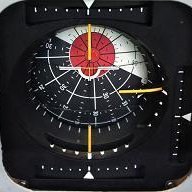BREAKING NEWS!
I made contact with David Rowe!
I had a good chat with him and he was most obliging with information.
He said that, as you know, efficiency of a wing drops off with aspect ratio, but then, at a certain point, it sharply rises again!
He says that when the aspect ratio hits approximately 1.25, it is almost the same as an aspect ratio of 6.
The aspect ratio of a complete circle is approximately 1.27, and so, with some added aerofoil at the rear, it is approximately 1.25.
It doesn't actually stall, so much as it mushes.
He didn't recall the actual point at which this happens knotswise.
Power-out, it glides slightly better than a Drifter.
It is very stable and flies quite well.
It lands quite short. (He often lands it in the driveway of many farms out where he lives.)
It's a standard aerofoil with a reflex (as all flying wings/tailless aircraft are.)
The model glider he built had a Centre of Pressure at about 33% but on the full-scale model that proved unstable, so it was best placed at about 25%.
As mentioned here before, the high undercarriage was due to the rotation angle and the need to avoid scraping your tail on the ground.
Also, he said that the seating arrangement was purely due to the fact that he sits, basically, on top of the wing.
He said that it's actually quite uncomfortable, so flights of more than an hour are not advised in this current model.
I told him of the interest in low-aspect ratio aircraft on both here and homebuiltairplanes.com.
I urged him to get onto this site as his knowledge would be invaluable - a person with first-hand experience is worth a thousand "internet armchair experts."
Sadly, he doesn't frequent the internet very much, so isn't interested in getting on this site.
He did, however, invite me to keep in contact and said that I am welcome to call any time I have questions.





